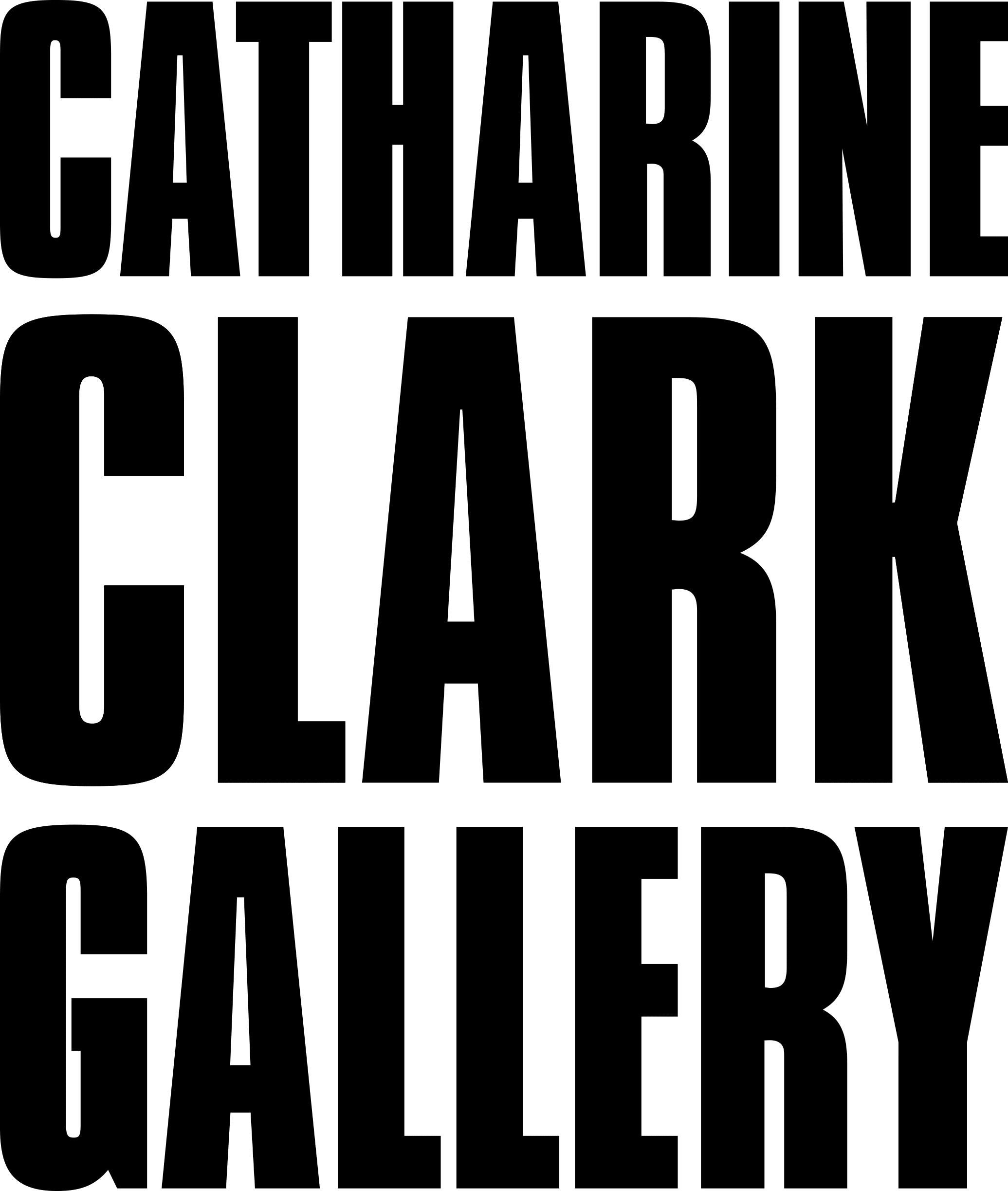Chris Doyle: You Should Lie Down Now and Remember the Forest
South Gallery and Media Room
Chester Arnold: Tributaries
North Gallery
On view January 6 – March 2, 2024
Opening reception: Saturday, January 6 from 3 – 5pm; artist talks at 4pm
San Francisco: Catharine Clark Gallery opens its 2024 program with solo exhibitions by Chris Doyle and Chester Arnold that powerfully reflect on nature, memory, loss, and healing. Doyle’s exhibition, You Should Lie Down Now and Remember the Forest, is on view in the South Gallery and Media Room and features watercolors, animation, and installation. Arnold’s exhibition of paintings, Tributaries, is on view in the North Gallery, with additional drawings on view in EXiT. Both exhibitions are concurrently on view January 6 – March 2, 2024, with an opening reception on Saturday, January 6 from 3 – 5pm; artist talks at 4pm.
Chris Doyle’s work often meditates on regenerative life cycles and the tension between destruction and repair. In 2017, Doyle concluded a multi-year project responding to Hudson River painter Thomas Cole’s five-painting series, The Course of Empire (1833 - 1836). The project imagined a landscape transforming from an agrarian space into a dense built environment, turning to ruin through overpopulation and pollution. In his previous exhibition, The Parables of Correction (2020), Doyle created intricately rendered animations and watercolors depicting a futuristic factory with strange machines and alien-like assembly line workers. Conceived during the Covid-19 pandemic, it emerged from a global moment that redefined shared concepts of progress, slowness, isolation, and connection.
You Should Lie Down Now and Remember the Forest – on view in the South Gallery and Media Room – builds on Doyle’s earlier work around landscape and memory. It evocatively depicts a forest transitioning through seasons and cycles of growth across three series of work. The exhibition prompts reflection on collective and personal losses during Covid-19, as well as the potential for new life and beginnings arising from loss.
Doyle began the watercolor series “The Newly Fallen” (2020 – present) after observing an unusually high number of uprooted trees at his home in Maine. He notes: “Every year, the forest where I live loses several old-growth trees to storms and high winds. In Spring 2020, at the height of the pandemic, I noticed more fallen trees than normal. As I mourned the loss of each tree, I also mourned the loss of my own elders who died during the pandemic from Covid-19.” In response to this overwhelming loss, Doyle created large format drawings, rendered in monochrome watercolor and mounted to panel, depicting fallen trees in the forest. Each drawing serves as a memorial to a friend or mentor who passed during the pandemic. Doyle’s drawings, both haunting and awe-inspiring in scale, create a contemplative space inviting us to consider life’s precarity and beauty. Doyle hints at signs of life in each drawing, writing: “I found myself marveling at the new growth springing from these fallen trees. Each drawing, by extension, is both a memorial to a fallen elder and a tribute to the continued impact that their lives will inspire.”
Doyle’s three-channel animation Junglegym, accompanied by a score by Todd Griffin, draws on the artist’s evolving sensory experiences of forests and trees from childhood to adulthood. Doyle notes: “Junglegym focuses on the impossibility of separating my exuberant childhood memories of forests from our present understanding of climate change. Through animation, I explore the fluidity of memory and interweave my childhood associations with a constellation of cultural information.” Doyle’s projection-based installation Nightwatch, by comparison, combines barrier grid animation, a 19th-century animation technique, with digital projection to create an immersive experience in the gallery’s Media Room that evokes a forest at night. Light projects onto an interlaced digital image, revealing an unseen energy that pushes the limits of our sensory experience and perception.
Doyle’s exhibition draws its title from a poem by Susan Stewart, which is reproduced at the end of this press release.
Chester Arnold infuses depths of feeling in crashing waves, cavernous ravines, and 400-year-old oak trees. His expressive oil paintings and drawings often depict psychologically and emotionally rich landscapes, and he writes that his work “reflects a mind’s natural and unrestrained adventures with friction and gravity at its core.” Several paintings in his last solo exhibition, Complications (2020), depicted dramatic and tumultuous seascapes – capsized ships and rafts adrift, flotsam jettisoned in the swell – suggesting an upturned and unstable world. The paintings in Tributaries – on view in the North Gallery – depict water in seemingly calmer states, with rivers and bays stretching and meandering through green banks. However, his landscapes suggest precariousness beneath the surface.
Arnold created this body of work shortly after a loved one’s illness. After an extended break, Arnold returned to the studio. His newest landscapes reflect on passage and connection: tributaries flow into one another; starlings amass in murmuration; old-growth trees stretch their roots and branches, inviting an onlooker to touch. Arnold writes: “The works in Tributaries are driven by a metaphorical instinct that guides everything in my life. Painting may not be science, but the gifts of its agency, in both practice and appreciation, have been both balm and elixir in a challenging time. The paintings that appear here flowered in an atmosphere of restoration and recovery.”
The Forest
by Susan Stewart
You should lie down now and remember the forest,
for it is disappearing—
no, the truth is it is gone now
and so what details you can bring back
might have a kind of life.
Not the one you had hoped for, but a life
—you should lie down now and remember the forest—
nonetheless, you might call it "in the forest,"
no the truth is, it is gone now,
starting somewhere near the beginning, that edge,
Or instead the first layer, the place you remember
(not the one you had hoped for, but a life)
as if it were firm, underfoot, for that place is a sea,
nonetheless, you might call it "in the forest,"
which we can never drift above, we were there or we were not,
No surface, skimming. And blank in life, too,
or instead the first layer, the place you remember,
as layers fold in time, black humus there,
as if it were firm, underfoot, for that place is a sea,
like a light left hand descending, always on the same keys.
The flecked birds of the forest sing behind and before
no surface, skimming. And blank in life, too,
sing without a music where there cannot be an order,
as layers fold in time, black humus there,
where wide swatches of light slice between gray trunks,
Where the air has a texture of drying moss,
the flecked birds of the forest sing behind and before:
a musk from the mushrooms and scalloped molds.
They sing without a music where there cannot be an order,
though high in the dry leaves something does fall,
Nothing comes down to us here.
Where the air has a texture of drying moss,
(in that place where I was raised) the forest was tangled,
a musk from the mushrooms and scalloped molds,
tangled with brambles, soft-starred and moving, ferns
And the marred twines of cinquefoil, false strawberry, sumac—
nothing comes down to us here,
stained. A low branch swinging above a brook
in that place where I was raised, the forest was tangled,
and a cave just the width of shoulder blades.
You can understand what I am doing when I think of the entry—
and the marred twines of cinquefoil, false strawberry, sumac—
as a kind of limit. Sometimes I imagine us walking there
(. . .pokeberry, stained. A low branch swinging above a brook)
in a place that is something like a forest.
But perhaps the other kind, where the ground is covered
(you can understand what I am doing when I think of the entry)
by pliant green needles, there below the piney fronds,
a kind of limit. Sometimes I imagine us walking there.
And quickening below lie the sharp brown blades,
The disfiguring blackness, then the bulbed phosphorescence of the roots.
But perhaps the other kind, where the ground is covered,
so strangely alike and yet singular, too, below
the pliant green needles, the piney fronds.
Once we were lost in the forest, so strangely alike and yet singular, too,
but the truth is, it is, lost to us now.
(From The Forest, copyright The University of Chicago Press, 1995. Used with permission of the author.)



